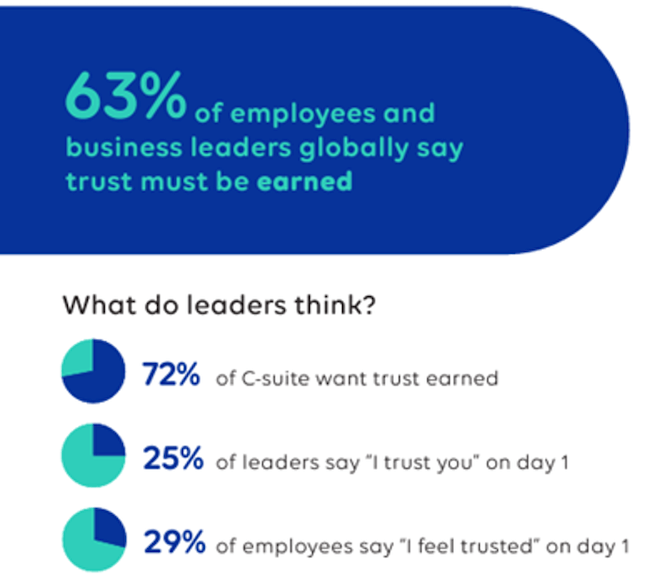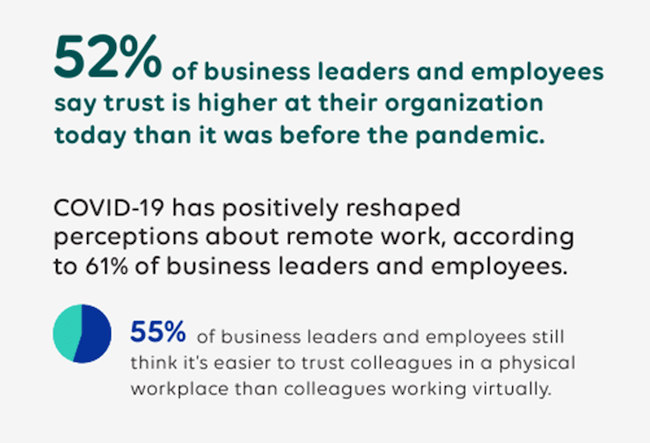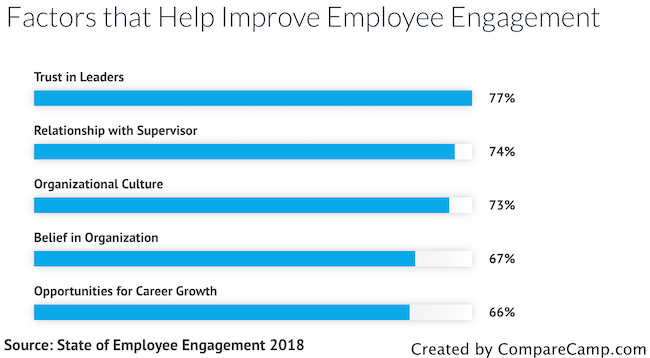“Trust is the magic glue that makes personal and professional relationships thrive. When we trust each other, everything becomes possible,” says Aron Ain, Chairman and CEO of Ultimate Kronos Group.
Creating an environment of trust is an important responsibility for a business leader. Successful workplaces are run on trust. When a team trusts its leader and each member, and the leader trusts the team, together they accomplish great things with less difficulty and better outcomes than teams that mistrust each other.
24% of respondents left their company because they did not feel trusted
Free eBook: Creating a culture of well-being
What are the misconceptions about employee trust?
There’s a popular, but outdated concept that ‘trust must be earned’.

So if ‘trust must be earned’, a personable new hire – who has been through the recruitment process, demonstrating qualifications, practical skills, and willingness to fit into the company culture –then has to win everybody’s trust.
What is the point? The new recruit was given the position because they were the candidate most trusted to make a success of the job. Now just let them get on with it.
It took the global pandemic to shift the needle on workplace trust issues. Suddenly, most employees were working at home, many with extra responsibilities such as simultaneously home-schooling children. There was no choice for employers but to trust employees to get the work done. And the workforce, by and large, rose magnificently to the challenge. They balanced home life and work life, changing leadership perceptions that unsupervised home workers couldn’t be trusted to get the job done.

There are still 55% of business leaders and employees who believe it’s easier to trust colleagues in-house rather than working remotely. Yet the popularity and benefits of hybrid work indicate that this will be the new normal for many businesses, so it’s essential that employees trust each other.
Businesses will now need to balance employees and teams, some of whom will work in a physical office, others who will adopt a ‘work from anywhere’ (WFA) pattern, and still more who will do a combination of both. Trust is essential for everyone to meet their full performance potential.
Learn more about employee trust
Why is leadership trust so critical for company success?
We all know that trust is a good thing: at home, in personal relationships, and at work. In business, trust:
Gives everyone the power to get the job done
When you’re trusted to get on with the job and manage it optimally for success, that’s a powerful thing. And that power breeds confidence, respect for leadership, and employee engagement.
Makes people fearless
Mistrust makes employees feel afraid: of making mistakes or a bad decision, for their job security, of their co-workers, even. And nobody can do their best work when they’re worried or scared. In a well-led environment of trust, employees can take risks, make mistakes, fail and learn, and seek guidance and support. A business is stronger for that.
Drives innovation
When a team trusts their leader, they’re empowered to speak up, share ideas, express opinions, and offer solutions. And with a diverse team, where people can be their authentic selves, you’ll hear different perspectives and things you may not have thought of.
Is its own damage limitation
Where people don’t trust their leaders, they’re more reluctant to admit to errors, mistakes, bad decisions, or accidents, and the consequences can spiral. In a high trust organization, employees are supported to admit their mistakes as soon as possible, own them, correct them, and learn from them. Damage can be caught early and rectified.
Encourages future leaders
Effective leadership is admired, and a role model for employees who aspire to leadership themselves. Successful leaders are resilient in adversity, take responsibility for their own results and performance, and become better. Their strengths develop other great leaders.
Engages employees
Leadership trust is the highest-ranked motivator of employee engagement, at 77%, higher than the organizational culture at 73%, and opportunities for career growth at 66%:

See how engaged your employees are with our free survey template
Low trust companies vs. high trust companies
Low trust companies
Workplace mistrust adversely holds a business back from reaching its full, successful potential. The bottom line is that most employees are conscientious and want to do the right thing. Trust (or mistrust) directly impacts belonging, career choice, and mental health:

According to research, low trust:
- Prevents top talent from applying for jobs – 74% of respondents prefer to work for a company with a trustworthy reputation
- Limits talent recommendation – 22% of employee respondents didn’t trust their company sufficiently to refer people to it
- Leads to attrition – 24% of respondents left their company because they did not feel trusted
- Causes employee disengagement – When employees don’t trust their leaders, they are less invested in their employee development, and not engaged with the business goals
High trust companies
Conversely, the way that high trust businesses build and maintain their workplace relationships benefits everyone – employees, managers, leaders, and the companies themselves. Employees of high trust companies report:
- 74% less stress
- 76% more engagement
- 50% higher productivity
- 106% more energy at work
- 13% fewer sick days
- 29% more life satisfaction
- 40% less burnout
How to build leadership trust
Start with trust itself
As mentioned above, the idea that ‘trust must be earned’ is an outdated one. How about this cutting-edge idea that instead, leaders trust their employees from day one, and continue to do so? Chances are, the majority of employees will reward that trust, and trust leadership back.
Be dependable
Leaders build trust when they are there for their team, supporting, checking in on them, and sharing expertise. Members can achieve so much more when they know their managers have their backs, and they are empowered to do their jobs, particularly where risk and innovation is concerned.
Model behaviors and lead by example
“Do as I say, don’t do as I do” is as outdated a concept as earning trust. The best leadership builds trust by modeling the behaviors they expect of a team and setting an example.
Be honest
There’s no better way of building trust than by being honest. When a team knows the truth they can deal with it, whereas dishonesty and cover-ups distort reality and make solutions impossible. Leaders who act with integrity ultimately get better team performance results.
Care about employee wellbeing
Empathy is an important attribute of a successful business leader. And empathy shows itself best when leaders genuinely care about the mental and physical health of their team members – whether they are remote workers or in the office.
Actively listen
When team members voice their wants, needs, and concerns, it’s essential that their leader listens. To maintain trust, a leader must recognize feedback as valuable insights to drive better results, then use their professional expertise and knowledge to act on what they have heard.
Give helpful feedback
Feedback works both ways when it comes to trust-building. Not only must a leader listen to feedback about themselves, but they must also have the ability to give constructive feedback to team members. This is where 360 feedback is critical – managers, peers, direct reports, and the person themselves all give their input and everyone benefits.
Direct, resource, and get out of the way
The best leadership, and individual leaders, build trust by setting out:
- a clear strategy for the organization
- achievable goals for team members
- real-time communication
- skills and resources to focus on those goals
- the commitment to stepping back and trusting people to do their job
- Being available for words of advice, but not micromanaging
Ultimately, create trust by setting clear goals, empowering workers to do their job, and leaving them to it. People are accountable, but they’re free to deliver for their organization. In short, you build trust by treating employees as the responsible adults they are.
Free eBook: Creating a culture of well-being